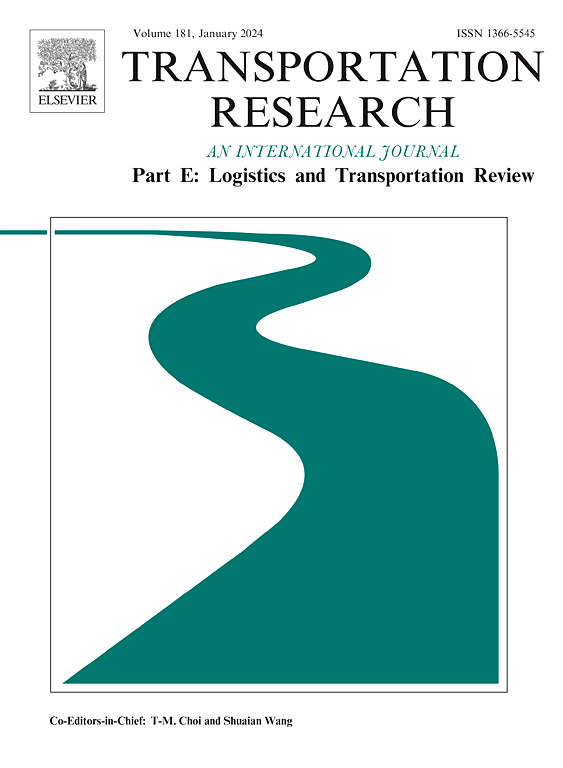智能装载区是否有助于减少交通拥堵?匹兹堡的因果分析
IF 8.8
1区 工程技术
Q1 ECONOMICS
Transportation Research Part E-Logistics and Transportation Review
Pub Date : 2024-10-07
DOI:10.1016/j.tre.2024.103796
引用次数: 0
摘要
对打车服务和电子商务配送的需求不断增长,加剧了对城市路边空间的竞争,导致出行行为不协调、交通拥堵加剧和社会成本增加。解决这些问题的一个可行方案是智能装卸区(SLZ),配备先进技术,优化路边空间的使用。然而,由于缺乏实际数据和对智能装载区对车速的因果影响的严谨研究,智能装载区对交通流量的实际影响尚不明确。本研究利用宾夕法尼亚州匹兹堡市的粒度车速数据和 SLZ 的实际实施情况,采用回归不连续设计方法,严格检验了 SLZ 对市中心交通网络车速的因果影响。结果表明,在控制车速基本趋势以及时间、天气和道路特征等多种影响因素的情况下,引入 SLZ 可将附近路段的车速提高 4.5%。此外,从统计学角度看,长度较短的分隔带可提高行车速度,但长度较长的分隔带则没有显著效果。这些不同的效果可能是由于匹兹堡在设置 SLZ 时执法不力造成的。研究结果证实了分隔带对改善交通拥堵的总体积极影响。然而,要最大限度地发挥 SLZ 的效益,有效的维度规划和强有力的执法政策是必不可少的。本文章由计算机程序翻译,如有差异,请以英文原文为准。
Do Smart Loading Zones help reduce traffic congestion? A causal analysis in Pittsburgh
Rising demand for ride-hailing services and e-commerce delivery intensifies competition for urban curbside spaces, leading to uncoordinated travel behavior, increased traffic congestion and social costs. One possible solution to address those issues is Smart Loading Zones (SLZs), equipped with advanced technologies to optimize curbside use. Yet, the real-world impact of SLZs on traffic flow is unclear due to a lack of real-world data and rigorous studies investigating SLZ’s causal effect on traffic speed. With granular speed data and real-world implementations of SLZs from Pittsburgh, PA, this study applies the regression discontinuity design method to rigorously examine the causal impact of SLZs on traffic speed in the downtown network. The results showed that the introduction of SLZs could enhance the traffic speed of the nearby road segments by 4.5%, while controlling for the underlying trend of speed and multiple influential factors such as time, weather, and road characteristics. In addition, SLZs with a short length could statistically improve traffic speed but those with a long length exert no significant effect. These heterogenous effects might be attributed to the weak enforcement at the time of SLZ deployment in Pittsburgh. The results confirmed the overall positive impact of SLZs on improving congestion. However, policies such as effective dimension planning and robust enforcement policies are essential to maximize the benefits of SLZs.
求助全文
通过发布文献求助,成功后即可免费获取论文全文。
去求助
来源期刊
CiteScore
16.20
自引率
16.00%
发文量
285
审稿时长
62 days
期刊介绍:
Transportation Research Part E: Logistics and Transportation Review is a reputable journal that publishes high-quality articles covering a wide range of topics in the field of logistics and transportation research. The journal welcomes submissions on various subjects, including transport economics, transport infrastructure and investment appraisal, evaluation of public policies related to transportation, empirical and analytical studies of logistics management practices and performance, logistics and operations models, and logistics and supply chain management.
Part E aims to provide informative and well-researched articles that contribute to the understanding and advancement of the field. The content of the journal is complementary to other prestigious journals in transportation research, such as Transportation Research Part A: Policy and Practice, Part B: Methodological, Part C: Emerging Technologies, Part D: Transport and Environment, and Part F: Traffic Psychology and Behaviour. Together, these journals form a comprehensive and cohesive reference for current research in transportation science.

 求助内容:
求助内容: 应助结果提醒方式:
应助结果提醒方式:


